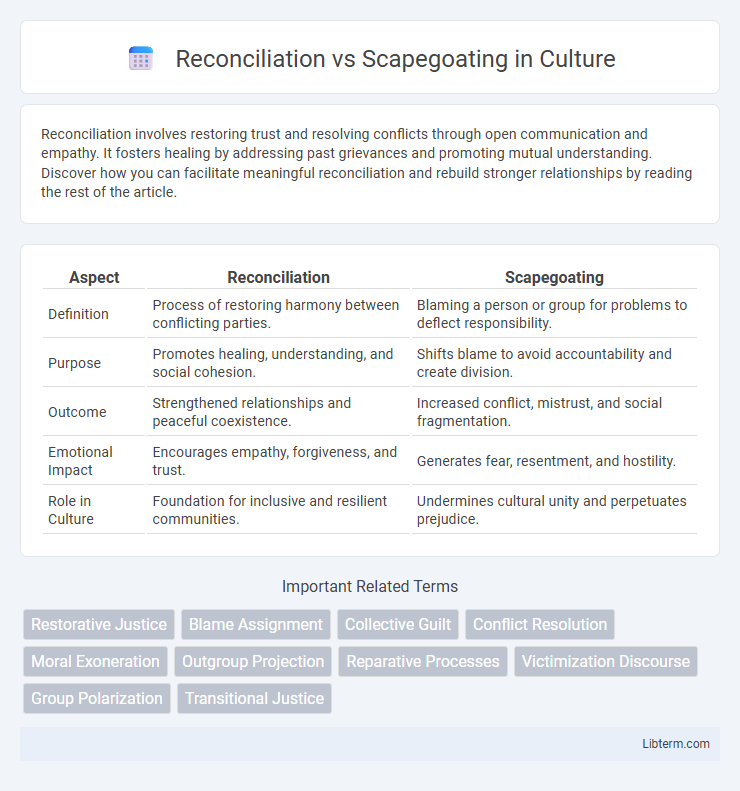Reconciliation involves restoring trust and resolving conflicts through open communication and empathy. It fosters healing by addressing past grievances and promoting mutual understanding. Discover how you can facilitate meaningful reconciliation and rebuild stronger relationships by reading the rest of the article.
Table of Comparison
| Aspect | Reconciliation | Scapegoating |
|---|---|---|
| Definition | Process of restoring harmony between conflicting parties. | Blaming a person or group for problems to deflect responsibility. |
| Purpose | Promotes healing, understanding, and social cohesion. | Shifts blame to avoid accountability and create division. |
| Outcome | Strengthened relationships and peaceful coexistence. | Increased conflict, mistrust, and social fragmentation. |
| Emotional Impact | Encourages empathy, forgiveness, and trust. | Generates fear, resentment, and hostility. |
| Role in Culture | Foundation for inclusive and resilient communities. | Undermines cultural unity and perpetuates prejudice. |
Understanding Reconciliation and Scapegoating
Reconciliation involves acknowledging past wrongs, fostering dialogue, and building trust to restore relationships and promote healing. Scapegoating shifts blame onto individuals or groups as a way to avoid accountability, often deepening conflict and hindering resolution. Understanding these dynamics is crucial for effective conflict transformation and long-term peacebuilding.
Historical Perspectives on Conflict Resolution
Historical perspectives on conflict resolution reveal reconciliation as a proactive process promoting healing and mutual understanding between opposing parties, often seen in post-apartheid South Africa and post-genocide Rwanda. Scapegoating, in contrast, historically exacerbates tensions by blaming a particular group for broader societal problems, evident in events like the Salem witch trials and the rise of anti-Semitism in pre-World War II Europe. These contrasting approaches highlight how reconciliation fosters sustainable peace, while scapegoating perpetuates cycles of violence and division.
Psychological Roots of Scapegoating
The psychological roots of scapegoating stem from an individual's need to reduce internal anxiety and avoid taking responsibility for personal failures by projecting blame onto others. This defense mechanism simplifies complex social or personal conflicts, allowing for temporary emotional relief at the cost of fairness and truth. Understanding these innate emotional triggers is essential in promoting reconciliation, which encourages empathy, accountability, and mutual healing rather than division.
Key Elements of Genuine Reconciliation
Genuine reconciliation involves acknowledgment of past wrongs, sincere apology, and a commitment to restorative justice that heals relationships. It requires trust-building measures, open dialogue, and mutual respect to address grievances without assigning undue blame. Unlike scapegoating, which diverts responsibility onto an individual or group, reconciliation promotes accountability and shared understanding for sustainable peace.
Social Dynamics: Unity vs Division
Reconciliation fosters social dynamics centered on unity, promoting collective healing and mutual understanding that strengthen communal bonds. Scapegoating drives division by unfairly blaming individuals or groups, deepening social fractures and perpetuating conflict. The choice between these approaches significantly impacts societal cohesion and the potential for lasting peace.
Consequences of Scapegoating in Society
Scapegoating in society fosters division, mistrust, and social instability by unfairly blaming individuals or groups for broader issues. This practice escalates conflict, perpetuates injustice, and undermines communal cohesion, often resulting in violence and discrimination. The long-term consequences include weakened social fabric and hindered progress toward reconciliation and collective healing.
Pathways to Healing and Forgiveness
Pathways to healing and forgiveness emphasize reconciliation by fostering open dialogue, empathy, and mutual understanding to restore relationships and build trust. Scapegoating obstructs healing by projecting blame onto individuals or groups, perpetuating division and resentment. Effective reconciliation requires acknowledging harm, embracing accountability, and creating inclusive spaces for shared growth and restorative justice.
Case Studies: Successes and Failures
Reconciliation efforts in post-conflict societies often succeed when inclusive dialogue and restorative justice practices are prioritized, as seen in South Africa's Truth and Reconciliation Commission, which effectively mitigated long-term grievances through acknowledgment and reparations. Conversely, scapegoating, exemplified by Rwanda's 1994 genocide aftermath where ethnic groups were blamed for systemic failures, has led to deepened divisions and cycles of violence, undermining peace processes. Case studies reveal that successful reconciliation depends on dismantling narratives of blame and fostering accountability, whereas scapegoating perpetuates exclusion and social fragmentation.
Reconciliation Strategies for Leaders
Effective reconciliation strategies for leaders involve fostering open communication, acknowledging past grievances, and promoting empathy among conflicting parties. Implementing restorative justice practices and creating inclusive dialogues help rebuild trust and address underlying issues without resorting to scapegoating. Prioritizing transparency, accountability, and collaborative problem-solving strengthens organizational cohesion and mitigates future conflicts.
Building Resilient, Inclusive Communities
Reconciliation fosters healing and unity by addressing historical injustices and promoting empathy, essential for building resilient, inclusive communities. Scapegoating undermines social cohesion by blaming marginalized groups, leading to division and persistent conflict. Prioritizing reconciliation strategies enhances trust, mutual respect, and collective resilience, empowering diverse communities to thrive sustainably.
Reconciliation Infographic

 libterm.com
libterm.com